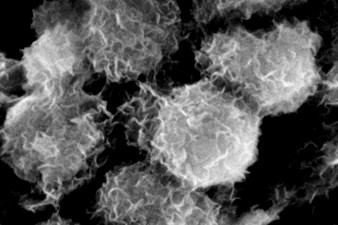-

This schematic depicts a process for converting waste packing peanuts into high-performance carbon electrodes for rechargeable lithium-ion batteries that outperform conventional graphite electrodes, representing an environmentally friendly approach to reuse the waste. (Purdue University image/Vinodkumar Etacheri)
WEST LAFAYETTE, Ind. – Researchers have shown how to convert waste packing peanuts into high-performance carbon electrodes for rechargeable lithium-ion batteries that outperform conventional graphite electrodes, representing an environmentally friendly approach to reuse the waste.
Batteries have two electrodes, called an anode and a cathode. The anodes in most of today’s lithium-ion batteries are made of graphite. Lithium ions are contained in a liquid called an electrolyte, and these ions are stored in the anode during recharging. Now, researchers at Purdue University have shown how to manufacture carbon-nanoparticle and microsheet anodes from polystyrene and starch-based packing peanuts, respectively.
“We were getting a lot of packing peanuts while setting up our new lab,” recalled postdoctoral research associate Vinodkumar Etacheri. “Professor Vilas Pol suggested a pathway to do something useful with these peanuts.”
This simple suggestion led to a potential new eco-friendly application for the packaging waste. Research findings indicate that the new anodes can charge faster and deliver higher “specific capacity” compared to commercially available graphite anodes, Pol said.
The new findings are being presented during the 249th American Chemical Society National Meeting & Exposition in Denver on March 22-26. The work was performed by Etacheri, Pol and undergraduate chemical engineering student Chulgi Nathan Hong.
“Although packing peanuts are used worldwide as a perfect solution for shipping, they are notoriously difficult to break down, and only about 10 percent are recycled,” Pol said. “Due to their low density, huge containers are required for transportation and shipment to a recycler, which is expensive and does not provide much profit on investment.”
Consequently, packing peanuts often end up in landfills, where they remain intact for decades. Although the starch-based versions are more environmentally friendly than the polystyrene peanuts, they do contain chemicals and detergents that can contaminate soil and aquatic ecosystems, posing a threat to marine animals, he said.
The new method “is a very simple, straightforward approach,” Pol said. “Typically, the peanuts are heated between 500 and 900 degrees Celsius in a furnace under inert atmosphere in the presence or absence of a transition metal salt catalyst.”
The resulting material is then processed into the anodes.
“The process is inexpensive, environmentally benign and potentially practical for large-scale manufacturing,” Etacheri said. “Microscopic and spectroscopic analyses proved the microstructures and morphologies responsible for superior electrochemical performances are preserved after many charge-discharge cycles.”
Commercial anode particles are about 10 times thicker than the new anodes and have higher electrical resistance, which increase charging time.
“In our case, if we are lithiating this material during the charging of a battery it has to travel only 1 micrometer distance, so you can charge and discharge a battery faster than your commercially available material,” Pol said.
Because the sheets are thin and porous, they allow better contact with the liquid electrolyte in batteries.
“These electrodes exhibited notably higher lithium-ion storage performance compared to the commercially available graphite anodes,” he said.
Packing-peanut-derived carbon anodes demonstrated a maximum specific capacity of 420 mAh/g (milliamp hours per gram), which is higher than the theoretical capacity of graphite (372 mAh/g), Etacheri said.
“Long-term electrochemical performance of these carbon electrodes are very stable,” he said. “We cycled it 300 times without significant capacity loss. These carbonaceous electrodes are also promising for rechargeable sodium-ion batteries. Future work will include steps to potentially improve performance by further activation to increase the surface area and pore size to improve the electrochemical performance.”
The researchers acknowledge funding from Purdue, the University’s School of Chemical Engineering and a Kirk Endowment grant from the Birck Nanotechnology Center. Purdue’s Office of Technology Commercialization filed a U.S. patent application on the technology in 2014.













